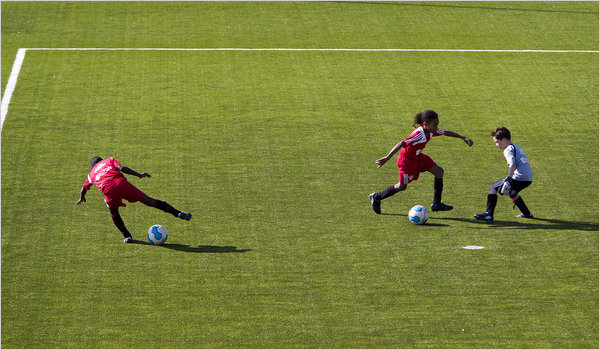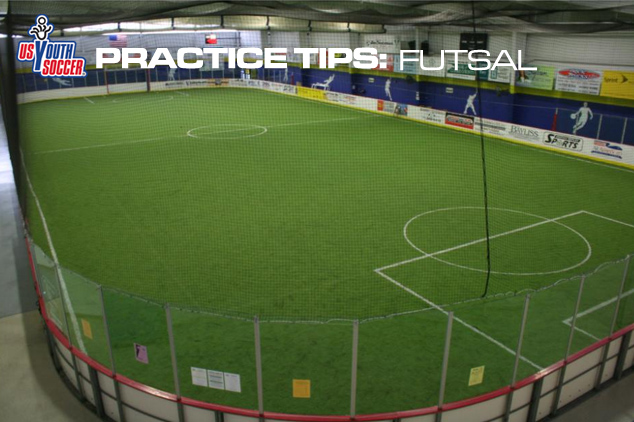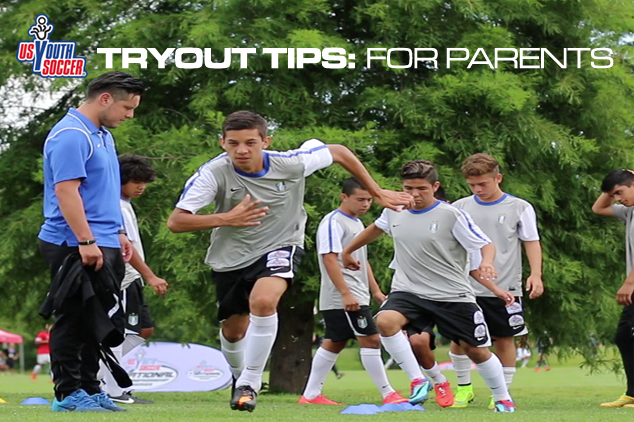|
|
How a Soccer Star Is Made
By MICHAEL SOKOLOVE
Published: June 2, 2010
NY Times
 The youth academy of the famed dutch soccer club Ajax is grandiosely called De Toekomst — The Future. Set down beside a highway in an unprepossessing district of Amsterdam, it consists of eight well-kept playing fields and a two-story building that houses locker rooms, classrooms, workout facilities and offices for coaches and sports scientists. In an airy cafe and bar, players are served meals and visitors can have a glass of beer or a cappuccino while looking out over the training grounds. Everything about the academy, from the amenities to the pedigree of the coaches — several of them former players for the powerful Dutch national team — signifies quality. Ajax once fielded one of the top professional teams in Europe. With the increasing globalization of the sport, which has driven the best players to richer leagues in England, Germany, Italy and Spain, the club has become a different kind of enterprise — a talent factory. It manufactures players and then sells them, often for immense fees, on the world market. “All modern ideas on how to develop youngsters begin with Ajax,” Huw Jennings, an architect of the English youth-development system, told me. “They are the founding fathers.”
The youth academy of the famed dutch soccer club Ajax is grandiosely called De Toekomst — The Future. Set down beside a highway in an unprepossessing district of Amsterdam, it consists of eight well-kept playing fields and a two-story building that houses locker rooms, classrooms, workout facilities and offices for coaches and sports scientists. In an airy cafe and bar, players are served meals and visitors can have a glass of beer or a cappuccino while looking out over the training grounds. Everything about the academy, from the amenities to the pedigree of the coaches — several of them former players for the powerful Dutch national team — signifies quality. Ajax once fielded one of the top professional teams in Europe. With the increasing globalization of the sport, which has driven the best players to richer leagues in England, Germany, Italy and Spain, the club has become a different kind of enterprise — a talent factory. It manufactures players and then sells them, often for immense fees, on the world market. “All modern ideas on how to develop youngsters begin with Ajax,” Huw Jennings, an architect of the English youth-development system, told me. “They are the founding fathers.”
In America, with its wide-open spaces and wide-open possibilities, we celebrate the “self-made athlete,” honor effort and luck and let children seek their own course for as long as they can — even when that means living with dreams that are unattainable and always were. The Dutch live in a cramped, soggy nation made possible only because they mastered the art of redirecting water. They are engineers with creative souls, experts at systems, infrastructure and putting scant resources to their best use. The construction of soccer players is another problem to be solved, and it’s one they undertake with a characteristic lack of sentiment or illusion.
The first time I visited De Toekomst happened to coincide with the arrival of 21 new players — 7- and 8-year-olds, mainly, all from Amsterdam and its vicinity — who were spotted by scouts and identified as possible future professionals. As I came upon them, they were competing in a series of four-on-four games on a small, artificial-turf field with a wall around it, like a hockey rink, so that balls heading out of bounds bounced right back into play. It was late November and cold, with a biting wind howling off the North Sea, but the boys skittered about in only their lightweight jerseys and baggy shorts. Their shots on goal were taken with surprising force, which kept the coaches who were serving as goalkeepers flinching and shielding themselves in self-defense. The whole scene had a speeded-up, almost cartoonish feel to it, but I certainly didn’t see anyone laughing.
After a series of these auditions, some players would be formally enrolled in the Ajax (pronounced EYE-ox) academy. A group of men standing near me looked on intently ...
full article >>
Indoor Training And The Use of Futsal as a Developmental Tool
By Dominic Casciato
 While clubs in the South and on the West
Coast enjoy training in the sunshine
year round, most of us are forced inside
at this time of year. Whether it’s two
bubbles with small turf fields, or
school gyms with hardwood floors, many
coaches are filled with dread at the
mere mention of training inside. This
shouldn’t be the case. While clubs in the South and on the West
Coast enjoy training in the sunshine
year round, most of us are forced inside
at this time of year. Whether it’s two
bubbles with small turf fields, or
school gyms with hardwood floors, many
coaches are filled with dread at the
mere mention of training inside. This
shouldn’t be the case.
Training
indoors or playing futsal is a great
development opportunity that can really
improve players individually and
collectively. It is certainly a
challenge for us coaches to prepare
sessions that are appropriate for
players, given the surface and space
available, but one we should fully
embrace.
One of the biggest opportunities of
training indoors is the potential to
increase players’ ability to operate in
tight spaces. With the limited space
that often comes with indoor facilities,
control of the ball has to be better.
Limited space inevitably leads to
limited time, so players must think
quicker and make better decisions. After
playing in this confined space, your
teams and the players within them should
be better equipped to deal with opposing
teams that play a high pressing game.
Now, it’s easy for me to sit here and
say, “players have to think quicker and
have better control”, but how do we
implement that as coaches?
Well, for a start, you have a choice
with regards to the type of ball you
choose to practice with. If you use a
futsal, which is smaller and heavier
than a regular ball, it will be easier
for players to control and there will be
fewer mistakes. This can be crucial to
building the players’ confidence in
their first touch, and something I’d
highly recommend with younger players.
However, with older players, it may
create a false sense of competency in
their first touch that doesn’t translate
to the outdoor game.
full article >>
Tips for Tryouts: Parents do your Research

Winter still remains in full swing, but soon the spring season will be upon us, which means club tryouts will be kicking into gear. US Youth Soccer sat down with current Loudoun 98 Red (VA) coach and 2014 US Youth Soccer Boys Competitive Coach of the Year, Mark Ryan, to discuss tips for parents in approaching tryouts.
Ryan holds a USSF ‘A’ License, and his Loudoun 98 Red team is fresh off a 2013-14 US Youth Soccer National League Blue Division title and a semifinals appearance at the 2014 US Youth Soccer National Championships. The first thing Ryan mentioned was that change for the sake of change isn’t always ideal.
“You need to work with your player’s coach and see where your son or daughter stands on the team and the roster pecking order,” Ryan said. “Keep your options open, but if your son or daughter likes the coach and the other players then sometimes the decision can be that simple.”
However, if a change appears to be in the cards, Ryan recommends parents do their research in regards to the club structure itself, as well as the coaches of your son or daughter’s age group.
“Parents should be looking at the entire club to see if the structure of developing players is in place. Do they have avenues for different playing levels?” Ryan said. “It is great to have top teams competing on the state, regional and national level, but if your son or daughter isn’t on that level then the club needs to be organized enough to have different playing levels.”
full article >>
|
|